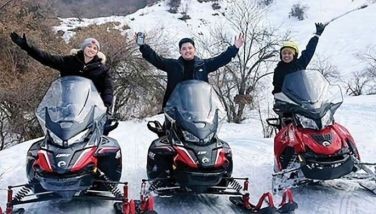The laughter & the style of Elvira Manahan
August 31, 2003 | 12:00am
 When you have so much money, you’d think you could live a life of leisure and not work anymore or contribute to society. Many of Manila’s society women aptly fit the preceding statement.
When you have so much money, you’d think you could live a life of leisure and not work anymore or contribute to society. Many of Manila’s society women aptly fit the preceding statement.
And yet, many others have chosen to depart from the mold, to do more than attend parties and to luncheons. In the process, they do not only serve humanity, they also become better persons and human beings. They are admired because they dared take risks that would have opened them up to ridicule and scorn. The upside is, of course, admiration and respect not only from the same circle but also the Filipino people.
Elvira Ledesma Manahan was one such lady of style and breeding who, instead of just keeping home for her children and the equally-famous Dr. Constantino Manahan, sought to make a difference.
Hers was not a lofty venue. To the upper class, the entertainment world was not exactly theirs to move in. But Elvira was her own woman, and she knew what she wanted. Her medium was television, a few times the movies and, occasionally, the stage for some walk-on part.
She is, of course, best remembered as the lady whose laughter kept you awake in that late night show that started in the late 1960’s, Two for the Road. But then, aside from the laughter, what she said or was about to say got you glued to the television box.
Manila’s High Society kept awake. It was their Elvira, after all, and she indeed proved this was no hoi polloi activity. And if she carried herself well on the fashion ramp or in a dinner table, she proved equally at home in front of the camera. And for those who had social aspirations, Elvira was not just another television emcee. It was this same woman of glamour that they admired in the society and fashion pages come alive right in their living room. What dress was she wearing? Was that anecdote she just said true, or was it all part of her witty repartee? Whichever, Elvira was a woman to copy. Although that required a certain flair too. After all, there was only one Elvira, just as there was only one Chona Kasten, or just one Baby Fores.
Interestingly, Two for the Road was not the first television offered to her by the ABS-CBN honcho, the late Geny Lopez. It was first a musical variety show and "it required a bit of singing, and I didn’t think my voice was good enough for a musical," Elvira explained in a published interview.
But there was a side to her that was undeniably an Elvira trademark. She loved being around people, being with people, and talking with people. So she took on the challenge of Two for the Road where, with a male host, first Joey Lardizabal then Eddie Mercado and finally Nestor Torre, she spoke con gusto, laughed without care, and spewed out those witty remarks that shocked, amused or even titillated the audience. All these, she did in that signature throaty voice, that she also commandeered for a duet with her co-host.
Once upon a time, she was a society belle who had wanted to enter the movies. Not afraid of what others might say, she followed the actress Yolanda Marquez around, who was and is Mary Prieto to readers and friends.
In time, Elvira would appear in a few plays, but her movies, few as they were, allowed her to assume personas that excited or fascinated the audience. In Alaga, she was the matron-benefactress of the young Edu Manzano. She also did a role in the Charito Solis starrer Ang Pulubi.
In reality, Elvira did not need any medium or venue in which to shine as a star. The lobby of a hotel, like the Lopezes’ Sheraton (now Hyatt) was enough for Elvira to hold her own court. The laughter signaled her presence, and everyone ogled, while those who would not be caught did so discreetly. If at all, it was fun to eavesdrop on what she was saying. Elvira was a quotable woman. When someone spoke of Manila’s 400, she retorted, "What Manila’s 400?" Elvira could be irreverent.
And when told that she did not need the money that came from hosting Two for the Road, she declared that "the talent fee was not to be sneezed at."
But then she also knew how to manage her resources. A source of wonder was how she could manage to look good on television, sporting all those dresses that were elegant or sporty or chic or simply mod, depending on how she wanted to feel that night, and she advised other women "to take a little time to plan out switches and accessories. A wardrobe could be doubled that way."
She admitted it was ridiculous to have as many as 260 outfits, which was the number needed if she had to have a daily change when the show was coming out five days a week. "I could use the money for something else," she said.
As the fashionistas of today await the forthcoming retrospective of Ramon Valera at the National Museum, which kicks-off with a charity dinner for the Philippine National Red Cross on Sept. 6, one is reminded of the special relationship that existed between Ramon Valera and Elvira Manahan.
As a young woman, she had already been going to Ramoning for her gowns. She was clearly a favorite muse, a walking mannequin who did not even need a ramp to show off the Master’s creations. An entrance by Elvira Manahan was more than enough to call attention to the superb design and execution of whatever she was wearing, most likely one by Ramon Valera.
The relationship would be strengthened by their common friendship with Don Luis Araneta, to whose children Elvira was a surrogate mother. Altogether, they were a part of the post-war scene that had Manila’s high society wanting to celebrate their reacquired freedom and embarking on a series of theme parties, with Don Luis and Ramoning collaborating on creating the set and ambiance to fit the costumes and fabulous gowns of the women, the most outstanding of which Ramoning himself designed.
Elvira recalled, in another interview, a particular merienda where Ramoning had been "assigned" to bring the lugao. He was of course a gourmet himself, so Don Luis relied on him for that particular culinary delight. As to how it would be served, the two had an argument and Elvira could not help laughing at the thought "that these were gentlemen who knew and enjoyed the good life, but who were arguing over, of all things, lugao." One could almost hear Elvira’s laughter reverberating as she told the story.
She recalled too how someone had wanted to give her a gown by Ramoning, "but the designer did not exactly like the person, but he made it anyway because the gown was for me." What Ramoning created was a surrealistic gown that Elvira said, "I never wore, not even if it was by Ramoning. It was so out of this world!"
Elvira was a lady who minced no words no wonder that she said all those interesting comments on television. She was, in her own words, naturally loquacious ("I talk too much.") and her show, Two for the Road simply fit her, with its spontaneous format that required a lot of conversations. It was a big hit, not only for other night persons like Elvira, but also for those who wanted to hear remarks and stories that, well, you could only hear from Elvira Manahan, and no one else.
We certainly miss Elvira, but for those who would want a look at some of the fabulous and exquisite Ramon Valera gowns that she wore in her legendary lifetime, the National Museum Exhibit runs from Sept. 8 until the end of October.
BrandSpace Articles
<
>
- Latest
- Trending
Trending
Latest
Trending
Latest
Recommended
































